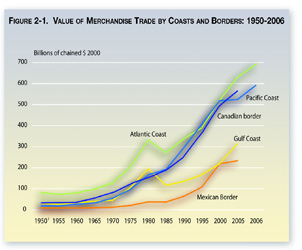Figure 2-1. Value of Merchandise Trade by Coasts and Borders: 1950-2006 (Chained $2000)
Foreign trade has had a major impact on all U.S. borders and coasts. Since 1950, the value of merchandise trade has grown sixteen-fold in inflation-adjusted terms. In 2006, ports and airports on the Atlantic Coast remain the most important, but the land borders and other coasts are catching up.

Data represented in the figure
Table in Excel format | Historical
data
| Customs District | 19501 | 1955 | 1960 | 1965 | 1970 | 1975 | 1980 | 1985 | 1990 | 1995 | 2000 | 2005 | 2006 |
|---|---|---|---|---|---|---|---|---|---|---|---|---|---|
| Atlantic Coast | 76.4 | 67.7 | 75.3 | 93.0 | 121.7 | 199.5 | 326.6 | 265.9 | 331.8 | 383.9 | 514.5 | 624.6 | 695.5 |
| Gulf Coast | 24.3 | 18.9 | 26.8 | 34.1 | 38.9 | 99.5 | 189.5 | 110.3 | 129.1 | 160.2 | 213.2 | 308.5 | 371.8 |
| Mexican Border | 4.0 | 3.5 | 3.7 | 5.2 | 7.6 | 15.8 | 33.1 | 32.7 | 59.6 | 102.8 | 214.2 | 228.7 | 260.9 |
| Pacific Coast | 13.2 | 13.3 | 20.3 | 27.7 | 49.0 | 91.1 | 160.8 | 186.6 | 290.4 | 401.5 | 513.0 | 518.4 | 588.4 |
| Canadian Border | 26.3 | 27.7 | 30.2 | 47.9 | 75.5 | 116.8 | 146.7 | 183.5 | 248.2 | 359.8 | 490.4 | 560.7 | 600.9 |
| Total | 144.1 | 131.0 | 156.3 | 207.9 | 292.7 | 522.6 | 856.7 | 779.0 | 1,059.0 | 1,408.3 | 1,945.3 | 2,240.8 | 2,517.6 |
11951
Sources: 1950-1970: U.S. Census Bureau, Historical Statistics of the United States, Colonial Times to 1970, Bicentennial Edition (Washington, DC: 1975); 1975: U.S. Census Bureau, Statistical Abstract of the United States: 1977 (Washington, DC: 1977); 1980-1985: U.S. Census Bureau, Statistical Abstract of the United States: 1987 (Washington, DC; 1986); 1990-2000: U.S. Census Bureau, Statistical Abstract of the United States: 2006 (Washington, DC; 2005); 2005-2006: U.S. Census Bureau, Foreign Trade Division, FT920 - U.S. Merchandise Trade: Selected Highlights (Washington, DC: December 2006) as of September 6, 2007; Implict GDP Deflator: U.S. Department of Commerce, Bureau of Economic Analysis, Current-Dollar and “Real” Gross Domestic Product, available at www.bea.gov as of September 6, 2007.
You will need the Adobe Acrobat Reader to view the PDFs on this page.
To view Excel files, you can use the Microsoft Excel Viewer.